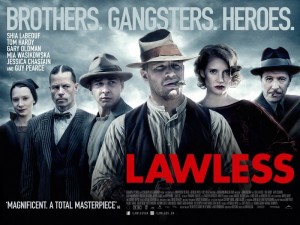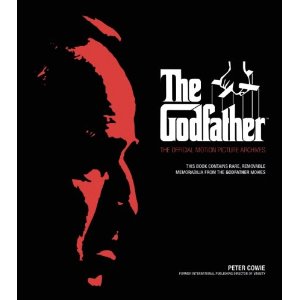 Musician Nick Cave and director John Hillcoat are Australians who are drawn to bleak internal and external landscapes. They worked together on “The Proposition,” a western-style and very violent crime story about brothers. “Lawless” is another crime story about brothers, again very violent and, like “The Proposition,” with a bleak setting and compromised characters. This one is a true story, based on Matt Bondurant‘s book about his Prohibition-era grandfather and great uncles, who were ran illegal hooch in Franklin County, Virginia, described by writer Sherwood Anderson as “the wettest county in the world.”
Musician Nick Cave and director John Hillcoat are Australians who are drawn to bleak internal and external landscapes. They worked together on “The Proposition,” a western-style and very violent crime story about brothers. “Lawless” is another crime story about brothers, again very violent and, like “The Proposition,” with a bleak setting and compromised characters. This one is a true story, based on Matt Bondurant‘s book about his Prohibition-era grandfather and great uncles, who were ran illegal hooch in Franklin County, Virginia, described by writer Sherwood Anderson as “the wettest county in the world.”
“There’s a feeling around these parts that these Bondurants is indestructible,” one character says. Forrest Bondurant (a quietly powerful Tom Hardy) came back from WWI without injury and the community almost believes the legend that he cannot be stopped. That’s good for business; you might even say it is their brand. But just as in legitimate enterprise, the success of a local operation selling moonshine in mason jars attracts the interest of the competition. The big bootlegging organization out of Chicago is thinking about what one might call a very hostile takeover. The Bondurants have a good relationship with the local sheriff, who is happy looking the other way for a small piece of the action. But a federal agent named Charlie Rakes (an oily and twisted Guy Pearce) arrives and for him it is not about law, morality, or directions from his superiors. It is about power. The Bondurants are not afraid of him and that is why he wants to destroy them. Pearce, in gloves and slicked-down hair parted in the middle, is one of the best villains of the year.
Forrest is the leader and he has an unspoken understanding with his brother Howard (Jason Clarke). Indeed, a lot that goes on here is unspoken. The youngest brother, Jack (Shia LeBoeuf) wants to prove himself to his older brothers. And he wants to prove something to a pretty churchgoing girl named Bertha (Mia Wasikowska). Brash and flashier than his brothers, he has the nerve to try to make a deal with machine gun-toting Chicago hood Floyd Banner (Gary Oldman) and the entrepreneurial instinct to improve and expand production and delivery. When he sees a brutal gangland slaying, his only thought is to grab a souvenir shell case. He will have a Michael Corleone moment when the violence gets closer to home. “It is not the violence that sets men apart,” Forrest says. “It is the distance he is prepared to go.” The Bondurants do not give up. It is not about the money. It is about defending their home and their right to make their own choices.
Maggie (Jessica Chastain) shows up out of the blue one day, offering her manicured hand to Forrest’s rough one and offering to work for the brothers. “The city can grind a girl down,” she tells Forrest. “Gets to a point where you start looking for somewhere quiet.”
Franklin County is far from quiet. But the noise Maggie wanted to escape was the cacophony of heartlessness she was surrounded by in the city. Everyone in this story is breaking the de jure law, but Maggie knows that the Bondurants have a core of integrity and loyalty that she can count on. And she will show that she can be counted on as well.
Strong performances and an evocative sense of time and place anchor the film and the unexpected tenderness of the romantic interludes balances the brutality. A coda provides perspective that just because someone is willing to go the distance does not mean he cannot come back home.
Parents should know that this is the true story of moonshiners during Prohibition, so the good guys are law-breakers and the police are corrupt. The movie includes extremely graphic violence with characters tortured, injured, sexually abused, and killed, strong language including a racial slur and segregation, sexual situations including prostitution, female nudity, and alcohol and smoking.
Family discussion: How were the brothers alike and how were they different? The script was written by musician Nick Cave – how does the music help tell the story?
If you like this, try: Lawless: A Novel Based on a True Story by the real-life grandson of the youngest Bondurant brother
by the real-life grandson of the youngest Bondurant brother
, which was made into a movie starring Harrison Ford. His latest project is a three-part story called “Rochelle,” starring Rosanna Arquette as a divorceé who hires a call girl to break her ex’s heart. And it’s on YouTube. You can watch it on the WIGS channel, with top talent producing high quality scripted stories about women.



